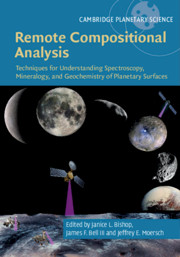 Remote Compositional Analysis
Remote Compositional Analysis from Part IV - Applications to Planetary Surfaces
Published online by Cambridge University Press: 15 November 2019
The first Laser-Induced Breakdown Spectroscopy (LIBS) instrument for extraterrestrial applications is part of the ChemCam instrument suite onboard the Curiosity Mars rover. ChemCam may be used in a number of operational modes depending on the science questions of interest, including active (with laser) and passive (spectrometers only) modes, and there is important synergy between ChemCam and other payload instruments. Notable discoveries made with ChemCam LIBS data include the characterization of hydrogen in rocks and soils, discovery of boron on Mars, and characterization of other trace elements (Li, F, Rb, Sr, Ba) that were previously never or rarely quantified on Mars, depth-dependent chemical trends on rock surfaces, and a much broader range of bulk-rock chemical compositions than was previously recognized, including highly evolved igneous rocks. In addition to ChemCam, another LIBS instrument is slated to fly to Mars on the Mars 2020 rover mission as part of the combined Raman-LIBS SuperCam instrument.
To save this book to your Kindle, first ensure [email protected] is added to your Approved Personal Document E-mail List under your Personal Document Settings on the Manage Your Content and Devices page of your Amazon account. Then enter the ‘name’ part of your Kindle email address below. Find out more about saving to your Kindle.
Note you can select to save to either the @free.kindle.com or @kindle.com variations. ‘@free.kindle.com’ emails are free but can only be saved to your device when it is connected to wi-fi. ‘@kindle.com’ emails can be delivered even when you are not connected to wi-fi, but note that service fees apply.
Find out more about the Kindle Personal Document Service.
To save content items to your account, please confirm that you agree to abide by our usage policies. If this is the first time you use this feature, you will be asked to authorise Cambridge Core to connect with your account. Find out more about saving content to Dropbox.
To save content items to your account, please confirm that you agree to abide by our usage policies. If this is the first time you use this feature, you will be asked to authorise Cambridge Core to connect with your account. Find out more about saving content to Google Drive.